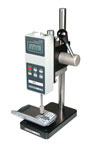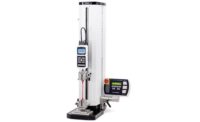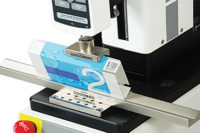
A tension spring is set up in a force testing system, consisting of a test stand, digital force gage and digital travel display. Source: Mark-10
In simplest terms, force testing instruments could be described as testing how much force is needed to break stuff. But that being said, this layman’s response is not complete. In fact, not all force testing has to result in breaking something. There are numerous nondestructive force measurement applications, and though many may be less exciting to describe in social circles, they are important to understand nonetheless.
A destructive force test is defined as a test in which the sample is damaged to the extent that it can no longer be used in its intended application. Typical applications include pulling a terminal off a wire or tube, peeling open a sealed pouch and pulling a component off a printed circuit board. A nondestructive force test is defined as a test of a component, material or other test sample that does not damage it to the extent that it may be used for its intended application. Let’s take a look at some applications.

A digital force gage is an integral part of numerous destructive and nondestructive force testing systems. Source: Mark-10
Spring testing
Springs are used in numerous applications, including aerospace, automotive, medical device and consumer products. Prior to their installment in a finished product, they need to be tested to ensure that the spring rate is appropriate, that is, that the relationship between force and travel distance-either compression, tension or torsion-falls within specification. A spring is typically compressed, pulled or twisted until a set distance value, and then the force is noted. Performing this test yields a wealth of information without destroying the sample.
A motorized test stand helps to fixture the force gage, sample and grips, while producing constant test speed. This helps achieve more consistent test results. Source: Mark-10
Connector insertion/withdrawal testing
Connectors used in wires and tubes are designed to make contact with a mating connector in a secure manner. Manufacturers of connectors must ensure that the amount of force to insert and withdraw the connector is in line with the design specifications. A connector that is too loose could cause a tube or wire to become disconnected, resulting in malfunction of the device in which it is used, presenting a range of negative consequences. Similarly, an excessive amount of force to insert or withdraw a connector also can be considered undesirable.
A switch on a mobile device is tested using a manual test stand and a digital force gage. Source: Mark-10
Force Measurement Instrumentation
One of the most basic force measuring instruments is the digital force gage, a handheld instrument that integrates a load cell with electronics and display. The gage will typically display force in units of pounds, Newtons or kilograms.Force gages and test stands are available in a wide range of force capacities, reflecting the great number of different products that need to be tested. Various grips and fixtures are available for use with these instruments, which vary based on the sample being tested. Many force gages and some test stands can output measurement data for further analysis.
Although most force gages are relatively simple to use, failure to follow some basic guidelines may result in instrument damage or lead to incorrect or inconsistent results.
In most manufactured component testing, it is critical that the load is applied axially with respect to the instrument. If not, load cell damage is possible, or the displayed force reading may be skewed because of the angle of measurement.
Another point to consider is that a force gage should not be used to measure shock or impact loads. A sudden buildup of force may not be measured accurately; force gages are most effective at longer duration tests.
Consistent speed is an important though often overlooked factor in force measurement. Because of this, handheld testing is not recommended for most applications. Depending on the test speed, a sample may require a greater or lesser amount of force to achieve the test’s objective. Whatever the speed, it should be consistent so that later tests can be compared according to the same parameters.
A motorized test stand or manual test stand, particularly hand wheel types, is useful in helping to achieve speed consistency. For some applications, such as spring testing, the travel distance observed during the test also is of value, and this is measured in inches or millimeters. Test stands also properly align the force gage and usually provide ample fixture mounting holes.
How to Interpret the Results
Force data can yield a wealth of information for quality assurance professionals. In most applications, the value of most interest is the peak force (maximum force), the sample experienced during the test. This force is often how manufacturers gauge the performance of their product.Although the maximum force is important, in many cases more data is required. In those cases, having the correct instrumentation and software is critical. Force measuring instruments can continuously output data to a PC or data collector for further processing and analysis. Force measurement software can accomplish a number of goals for quality professionals, including: Plot force vs. time or force vs. distance. A graph can be helpful in visualizing its behavior under stress. The slope and behavior of a curve can shed light on many aspects of the sample, helping identify problems and characterizing its behavior. Aside from plotting real-time data for a single test, software may be used to collect results from multiple tests in order to provide statistical analyses of a batch or lot.
Statistical calculations. Values such as minimum, maximum, mean and standard deviation can help quantify the quality of a product.
Data management. Data can be formatted into reports that include data in tabular and graphical format, or only selected data points. Data export capabilities allow the operator to customize data presentation to their needs through the use of programs such as Microsoft Excel.
Through the use of force measuring instruments, numerous nondestructive testing requirements can be accomplished, helping quality control professionals ensure that the products used in industry and everyday life operate as their engineers intended.Q
Tech tips
- A destructive force test is a test in which the sample is damaged to the extent that it can no longer be used in its intended application.
- A nondestructive force test is defined as a test of a component, material or other test sample that does not damage it to the extent that it may be used for its intended application.
- In most applications, the value of most interest is the peak, or maximum, force.
Switch activation force testing
Switches are integral parts of electric and electronic devices used in industry and everyday life. There are several types of switches, including tactile switches, rotary switches, toggle switches, even the keys on a digital piano.With any switch, there is a certain amount of force required to close the circuit. It is possible to measure the force at which contact is made, giving switch manufacturers an indication of whether the switch performs to specification. This is a nondestructive test in that the switch can go on to be used following a test.

